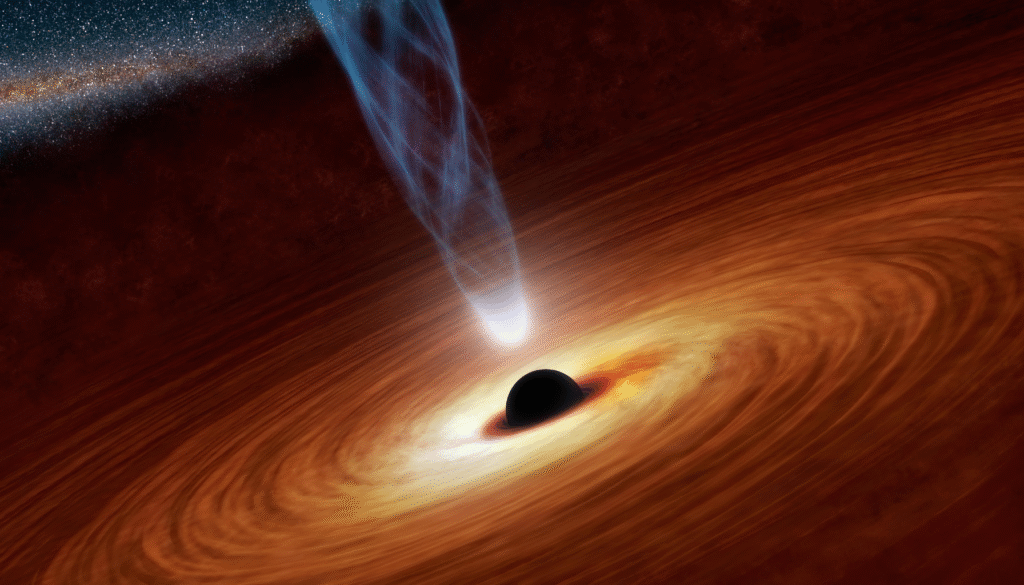They’re invisible, mysterious, and powerful enough to swallow stars whole. But what exactly are black holes—and why are scientists so obsessed with them?
For decades, black holes have captured the imagination of astronomers, physicists, and science lovers around the world. They’re more than just cosmic vacuum cleaners—they’re key players in how our universe works, evolves, and maybe even ends.
Let’s break down what black holes really are, how they form, and why they matter more than most people realize.
1. What Is a Black Hole?
A black hole is a region in space where gravity is so intense that nothing—not even light—can escape its pull. That’s why they’re called “black”—they don’t reflect or emit visible light.
At the center of every black hole is a point called a singularity, where mass is compressed into an infinitely small space and the laws of physics as we know them break down.
Surrounding the singularity is the event horizon—the boundary beyond which nothing can escape.
2. How Are Black Holes Formed?
Most black holes form from the collapse of massive stars.
Here’s how it happens:
- A star burns fuel through nuclear fusion for millions of years.
- When it runs out of fuel, it collapses under its own gravity.
- If the star is massive enough, this collapse creates a black hole.
Other types of black holes can form from:
- Mergers of smaller black holes
- Dense matter clouds collapsing in the early universe
- Supermassive black holes growing at the centers of galaxies
3. Types of Black Holes
🕳️ Stellar-Mass Black Holes
- Formed from dying stars
- 5 to 100 times the mass of our Sun
- Found scattered across galaxies
🌀 Supermassive Black Holes
- Millions to billions of times the mass of the Sun
- Reside at the center of galaxies—including our own Milky Way
- Mysteriously huge compared to what we’d expect from natural growth
⚫ Intermediate Black Holes
- Not too big, not too small—rare and hard to detect
- May be stepping stones in the formation of supermassive ones
🌌 Primordial Black Holes (Theoretical)
- Possibly formed right after the Big Bang
- Could be tiny, or massive—still hypothetical
4. What Happens If You Fall Into a Black Hole?
Short answer: You wouldn’t survive. But what happens depends on the size of the black hole.
In a smaller black hole:
- Gravity near the event horizon is extremely strong.
- You’d be stretched vertically and compressed horizontally—a process scientists call “spaghettification.”
- Your atoms would be torn apart long before reaching the center.
In a supermassive black hole:
- The gravitational gradient is more gentle.
- You might cross the event horizon without noticing (but you still wouldn’t come back).
Whatever falls into a black hole is lost to the observable universe—at least for now.
5. Can We See Black Holes?
Not directly—but we can observe their effects.
Astronomers detect black holes by looking for:
- Gravitational pull on nearby stars
- High-energy X-rays emitted by matter spiraling into the black hole
- Gravitational waves from black hole mergers (detected by observatories like LIGO)
In 2019, the Event Horizon Telescope team captured the first-ever image of a black hole—a glowing ring around a dark shadow in galaxy M87.
It was a breakthrough that confirmed decades of theory.
6. Why Do Black Holes Matter?
Despite being invisible, black holes play a crucial role in the universe.
Here’s why they matter:
- Galactic Architects: Supermassive black holes are found at the center of almost every galaxy—and may help shape them.
- Cosmic Timekeepers: They affect the movement of stars, gas, and light across billions of light-years.
- Extreme Physics Labs: Studying black holes helps scientists test Einstein’s theory of relativity, quantum mechanics, and the limits of our understanding.
- Clues to the Beginning—and End—of the Universe: The singularity might offer insights into the conditions of the Big Bang or the fate of space-time itself.
7. Could Black Holes Be Portals?
Some theories suggest black holes could be:
- Gateways to other universes
- Time machines (in theory!)
- Wormholes connecting distant parts of the cosmos
But these ideas remain purely speculative. For now, we see black holes as one-way tickets—things go in, but never come out.
8. Are There Black Holes in Our Galaxy?
Yes! Our very own Milky Way has a supermassive black hole at its center called Sagittarius A* (pronounced “A-star”).
It’s about 4 million times the mass of our Sun and sits about 26,000 light-years from Earth.
Don’t worry—it’s not coming for us. We’re far enough away to be completely safe.
Final Thoughts: Why Black Holes Capture Our Imagination
Black holes aren’t just scientific objects—they’re symbols of the unknown. They represent the limits of what we know about reality, space, time, and existence itself.
They challenge everything we think we understand—and remind us that the universe is bigger, stranger, and more mysterious than we can imagine.
So next time you look up at the night sky, remember: somewhere out there, a black hole is silently shaping the universe. And it might even be holding the secrets to where we came from—and where we’re going.



